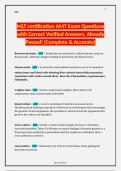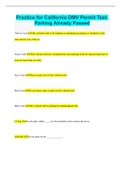1
Mlt
MLT certification AMT Exam Questions
with Correct Verified Answers, Already
Passed! (Complete & Accurate)
fluorescent stains - ANS ✓Antibodies are attached to a fluorochrome (such as
fluorescein). Antibody-antigen binding is detected by the fluorescence.
Giemsa stain - ANS ✓is used when intracellular structures are to be examined.
stains tissue and blood cells showing blue-colored intracellular parasites,
sometimes with a halo around them., Borrelia, Plasmodium, trypanosomes,
Chlamydia
wrights stain - ANS ✓Used to stain blood samples; fixes stain to cell
components; must counter stain with buffer
blood culture - ANS ✓a test to determine if infection is present in the
bloodstream by isolating a specimen of blood in an environment that encourages
the growth of microorganisms; the specimen is observed and the organisms that
grow in the culture are identified
urine culture - ANS ✓Sterile or Clean voided sample of urine to determine
bacterial sensitivity. Takes 24-48 hours to report findings of bacteria growth so a
broad spectrum antibiotic is prescribed until the results are confirmed, then a
new antibiotic is ordered.
stool culture - ANS ✓laboratory test of feces to determine if any pathogenic
bacteria are present
Mlt certification
, 2
Mlt
sputum culture - ANS ✓Sputum is collected and placed on a growth medium to
analyze the type of microorganisms that may be prevented.
throat culture - ANS ✓test for streptococcal or other infections in which a swab
taken on the surface of the throat is placed in a culture to see if certain bacteria
grow
spinal fluid culture - ANS ✓method is used for detecting meningitis
wound culture - ANS ✓Performed on wound exudate to determine the presence
of microorganisms and to identify the specific type. An effective antibiotic can be
prescribed for identified microbes.
oxidase test - ANS ✓A test to distinguish colonies of Neisseria from some other
bacteria; it does not differentiate Neisseria species. Neisseria are oxidase positive
and the colonies first turn pink, then dark red, and finally black.
catalase test - ANS ✓this test is used to differentiate between gram positive
cocci. It differentiates Staphyloccocus (positive) and Streptococcus (negative)
bile solubility - ANS ✓test to differentiate S.pneumoniae from other alpha-
hemolytic streptococci; all other members of streptococcus will not be lysed by
the bile/bile salts in this test and are bile-insoluble;
*S. pneumoniae undergoes lysis
optochin disk (P DISK) - ANS ✓Differentiates microorganisms based on
susceptibility to ethyl hydrocupreine hydrochloride., * S. pneumoniae
* Zone of inhibition >/ 14mm w/a 6mm disk
* Differentiate S. pneumoniae from viridans strep
Mlt certification
, 3
Mlt
bile esculin - ANS ✓Gram-positive other than some streptococci and enterococci
are inhibited by the bile in this medium. If streptococci enterococci can grow in
the presence of 40% bile and hydrolyzeesculin, they subsequently turn the
indicator, ferric ammonium citrate, a dark brown color. This dark brown color
results form the combination of esculetin with ferric ions to form a phenolic iron
complex.
mannitol salt test - ANS ✓MSA - selective for Staphylococcus genus - detects
mannitol fermentation
indole test - ANS ✓Tests organisms ability to breakdown Tryptophan to indole.
Utilized Kovac's reagent. Positive - Red, Negative- No color change
camp test - ANS ✓Confirmatory test for group B Strep. (Strep. agalactiae),
unknown beta Strep. is streaked perpendicular to Staph. aureus on blood agar
TSB - ANS ✓Tryptic Soy Broth (TSB) is a nutritious medium that will support the
growth of a wide variety of microorganisms, especially common aerobic and
facultatively anaerobic bacteria
Enzymatic digests of casein and soybean meal provide amino acids
and other complex nitrogenous substances. Glucose (=dextrose) is an
energy source. Sodium
chloride maintains the osmotic equilibrium. Dibasic potassium phosphate
acts as a buffer to
control pH
gram positive bacilli - ANS ✓This stains Purple in a Gram stain, bacteria that
retains purple stain inside the cell wall during the Gram staining procedure
brucella - ANS ✓an aerobic Gram-negative coccobacillus that causes brucellosis
Mlt certification
, 4
Mlt
bordetella - ANS ✓This nonmotile, aerobic, gram negative bacteria cause a
serious disease called pertussis or whooping cough
HACEK - ANS ✓is a list of common causes of subacute (develops in weeks)
culture negative (hard to grow these in culture from blood) endocarditis
They include H. influenza, Actinobacillus, Cardiobacterium, Eiknella,
Kingella
Pseudomonas - ANS ✓Gram -, aerobic rods. Dermatitis- swimming pool, hot tub,
sauna. Wound and skin infections. Otitis externa- swimmer's ear. Burn infections.
Blue-green pus
campylobacter - ANS ✓Curved, spiral, gram neg rods. Microaerophilic, prefer
42C. Oxidase positive. one of MC enteritis cause in N.A. teens, fever, malaise,
diarrhea, severe ab cramping, and some blood in feces. Assoc. with Gillian barre,
arthritis, and Reiters (antigen cross rxn)
Anaerobic bacteria - ANS ✓Do not like 02, 02 can be toxic depending on type of
Anaerobe. Grow in bottom.
fusobacterium - ANS ✓related to bacteroides - pleomorphic, gram negative
bacilli, normal flora of oral cavity and or intestinal tract, frequently caus mixed
infections
F nucleatum - long thin bacilli with pointed ends - fusiform morphlogy,
normal oral flora, most commonly isolated species, oral infections, lung
abscesses
F. necrophorum - normal intestinal flora, abdominal and liver abscesses
Mlt certification





